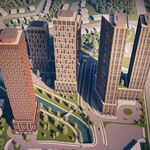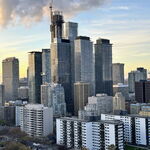doady
Senior Member
doady, have you figured out an approximate cost of implementing your system?
Not really. I don't think it is unrealistic though...
doady, have you figured out an approximate cost of implementing your system?
Toronto does not build subway stations on curves. It's an absolute rule for the TTC.
I'm not sure what you're talking about with those stations, but a subway train is not capable of 90 degree turns. Union is the absolute bare minimum curvature, and it swings out over a deceptively large distance. We wouldn't likely build like that anymore, either.
You've got to remember that the point of a transit route isn't to connect the dots between nodes. It's to get people where they want to go. Are there really large numbers of people going from St. Lawrence to Little Italy? Probably not, and definitely not enough to justify an underground subway route. Established travel patterns in the city are east-west and north-south.
You've got to remember that the point of a transit route isn't to connect the dots between nodes. It's to get people where they want to go. Are there really large numbers of people going from St. Lawrence to Little Italy? Probably not, and definitely not enough to justify an underground subway route. Established travel patterns in the city are east-west and north-south.
it is able to have different trains (designed for large amounts of people carrying luggage?) and frequencies. Or instead perhaps it is actually light-rail or it uses standard gauge... none of these are specified on the map for a reason.
As for the base map, I drew it myself, partly based on Google maps. This is a fantasy map so it shows some roads that don't exist yet (like the future extension of Creekbank Road in Mississauga) and some others have been modified. And of course Google is quite outdated to begin with and GTA is growing very quickly. The base map also shows a complete Terminal 1 at the airport which I found the plan for at the GTAA website.
I am surprised there so much opposition to the Bay subway line yet none at all for Hurontario subway! In fact one person even called for the Hurontario line to be even longer!
Which is why we need a DRL. It enhances our east-west, north-south travel patterns while also connecting nodes. It would very well alter the way we think about getting around this city.I know there is an established north-south, east-west transit pattern, but that's only because there aren't any other options. If people were given the option to traverse the city without having to go across and down, or up and then across then it might alter the way we think of our city.
What about the airTrain which uses the same kind of technology as Vancouver? Or that doesn't really count?
Wow, really!? Good job, it looks really professional. Would you consider posting just your base map (perhaps with a copyright to yourself in one corner) so that others wanting to make a dream map or other Toronto map have something to work with?
I think people are simply choosing to ignore it.
Despite not having any subway connection, Hurontario is much busier than Yonge in York Region: 19 Hurontario has 23,000 riders per weekday while VIVA Blue only has 16,000, only slightly higher than 1 Dundas. Yet it is the Yonge extension that people would support more.
Apart from expenses and general apathy from the public there's really nothing stopping such a line from existing, and in effect bringing much needed traffic and tourism to at-risk dentrificated neighborhoods.
Mind you, VIVA Blue is only one of the buses that do Yonge in York Region: certainly the GO Yonge 99 bus, possibly the GO Newmarket B bus, maybe the YRT 5 and 77 routes (which go up Yonge from Finch then branch off at Clark and at Centre respectively). And don't forget all the TTC Steeles buses which load Yonge from Finch to Steeles as well.
People might not want to go from Wellesley to Rosedale, but there are stops there. Just because that exact route isn't popular doesn't mean people wouldn't use that line. I know there is an established north-south, east-west transit pattern, but that's only because there aren't any other options. If people were given the option to traverse the city without having to go across and down, or up and then across then it might alter the way we think of our city. I'm not saying build a subway at 45 degrees just for the sake of it. I'm saying if there are important pockets that warrant a subway stop then why not find a way to service them? It might also take some pressure off of some of our over-crowded street car lines too.
What's an 'at-risk dentrificated neighborhood'? One at risk of being lorded over by Dentrobate54, or one where people are at risk of not affording toothpaste?




